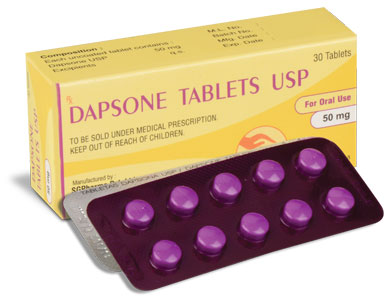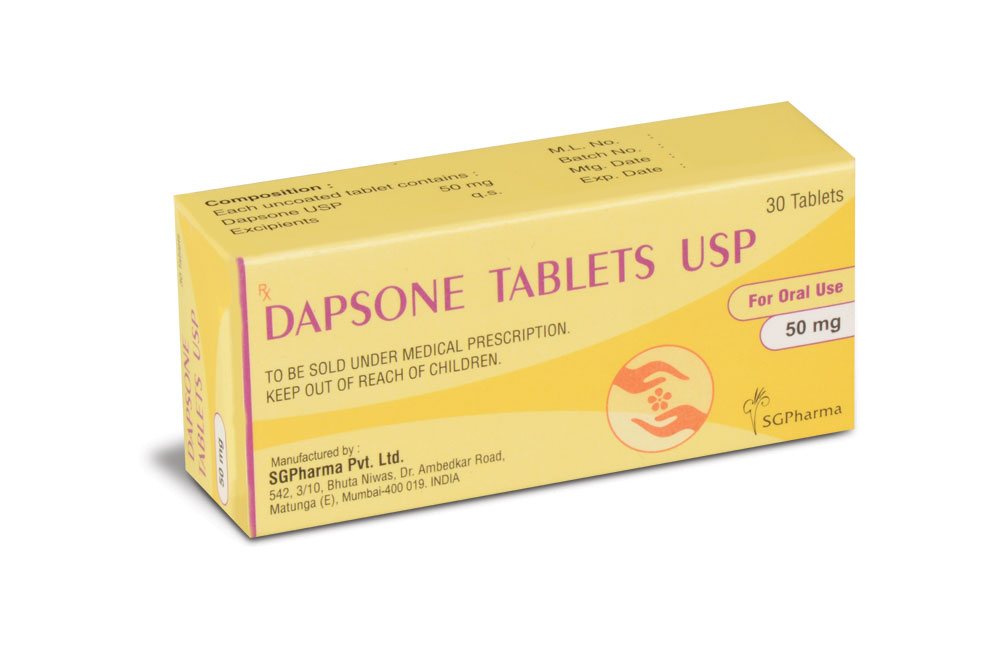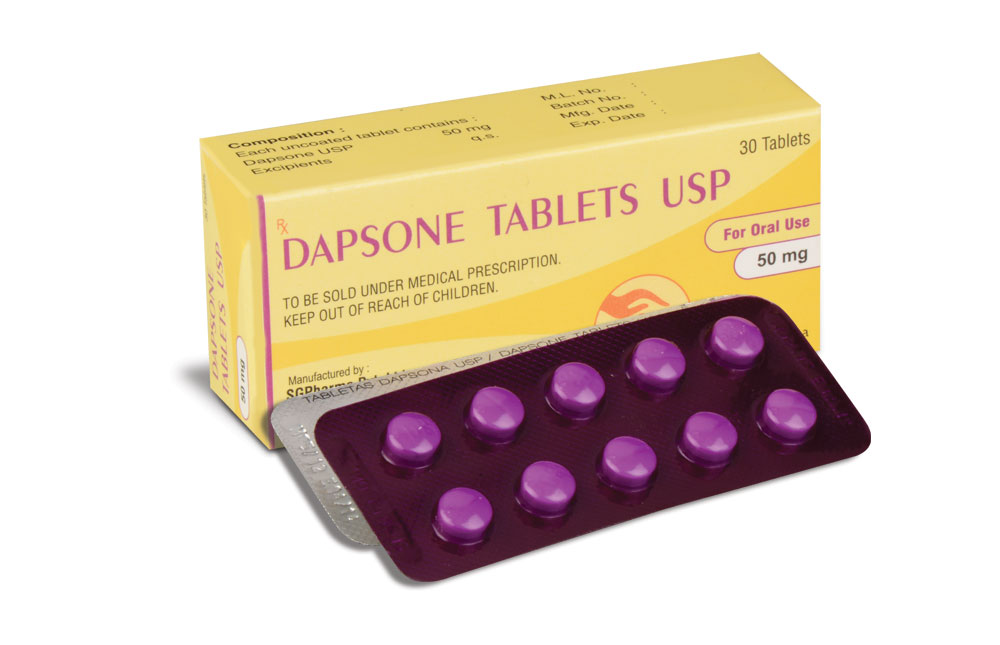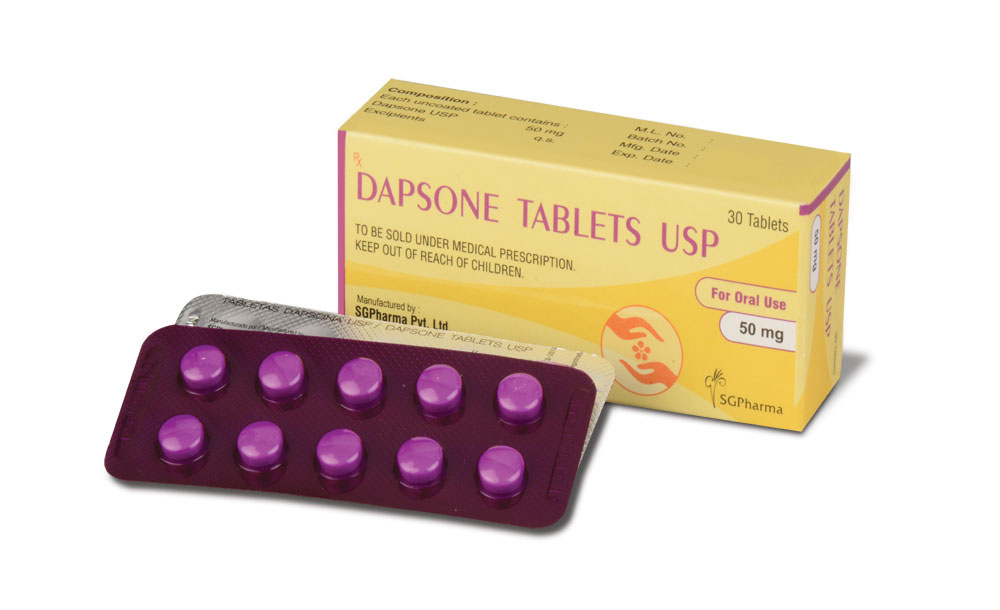
50 mg, 100 mg
For the use of a Registered Medical Practitioner or a Hospital or a Institution only.
DABSON (Dapsone) is sulfone, active against a wide range of bacteria, but it is used for its action against Mycobacterium leprae. Chemically, Dapsone is 4,4’-sulfonyldianiline. The molecular formula is C12H12N2O2S and the molecular weight is 248.30.
STRUCTURAL FORMULA :
Its structural formula is :
-Structure.jpg)
DABSON 25 mg tablets are white in colour, round, beveled, scored and debossed with SGP on one side. DABSON 50 mg tablets are white in colour, round, beveled, scored and debossed with SGP on one side. DABSON 100 mg tablets are white in colour, round,
beveled, scored and debossed with SGP on one side.
COMPOSITION :
DABSON 25
Each uncoated tablet contains :
Dapsone USP........................... 25 mg
Excipients...................................... q.s.
DABSON 50
Each uncoated tablet contains :
Dapsone USP........................... 50 mg
Excipients...................................... q.s.
DABSON 100
Each uncoated tablet contains :
Dapsone USP..........................100 mg
Excipients.......................................q.s.
ACTIONS :
Antibacterial (antileprosy agent) – Dapsone, a sulfone, is bacteriostatic and probably acts by a mechanism similar to that of the sulfonamides, interfering with folate synthesis. Both have a similar range of antibacterial activity and are antagonised by paraminobenzoic acid.
Dermatitis herpetiformis suppressant – Mechanism is unknown, but not due to dapsone’s bacteriostatic effect. Dapsone may act as an enzyme inhibitor or oxidizing agent. In addition, it has numerous immunologic effects (e.g. immunosuppression), which most likely account for its suppression of dermatitis herpetiformis.
PHARMACOKINETICS :
Absorption :
Dapsone is slowly absorbed from the gastrointestinal tract with an absorption half-life of 1.1 hours. Overall bioavailability is 70 - 80 %; may be less in patients with severe leprosy. An acidic environment is needed for optimal absorption.
Distribution :
Dapsone is well distributed throughout the total body water and is found in all tissues, especially liver, muscle, kidneys and skin. Saliva concentrations are 18 - 27 % of corresponding plasma Dapsone concentrations. Dapsone also crosses the placenta. VolD - 1.5 L per kg (1.9 L per kg when given with pyrimethamine).
Protein Binding :
Dapsone - moderate to high (70 - 90 %); Monoacetyl Dapsone (MADDS) - Very high (99 %). Biotransformation : Dapsone is acetylated by N-acetyl transferase in the liver to its major metabolite, monoacetyl Dapsone (MADDS). MADDS is also deacetylated to Dapsone; equilibrium is reached within a few hours. Patients may be divided into slow or fast acetylators. However, unlike with other medications, no relationship has been seen between acetylator type and side effects. There was also no significant difference between the two
groups in plasma concentrations or pharmacokinetics; therapeutic response was the same in both groups. Dapsone is also N-hydroxylated to Dapsone hydroxylamine in the liver by the mixed oxidase system in the presence of oxygen and NADPH, and appears to be responsible for the drug’s haematologic toxicity. Both major metabolites have very low activity and do not contribute to the therapeutic effect of Dapsone.
Elimination Half life :
10 to 50 hours (average, 30 hours) for both Dapsone and MADDS. Time to peak serum concentration is 2 to 6 hours, but variable.
INDICATIONS :
DABSON is indicated in the treatment of all types of leprosy; especially lepromatous and tuberculoid leprosy. In addition it has also been found of value in the treatment of dermatitis herpetiformis. It is also of value in the treatment of toxoplasmosis and mycetoma (maduromycosis) and it has a suppressive action on malarial plasmodia.
Administration :
The tablets should be taken with plenty of water. It is important not to miss any dose and to take the tablets same time everyday. Complete the course.
Dosage :
Dermatitis herpetiformis :
Adults :
The usual maintenance dosage is 50 to 100 mg daily, but as little as 50 mg weekly may be adequate. Dosages of up to 300 mg daily may be considered, but efforts should be made to reduce this to the minimal maintenance dosage as soon as possible.
Leprosy :
Adults : The standard dose is 100 mg daily (1 to 2 mg/kg body weight).
Children : Dosage should be adjusted according to body weight. Those aged 10 to 14 years daily doses of Dapsone 50 mg or 1 to 2 mg/kg if their body weight is low, can be given. The modern treatment of leprosy involves the use of multiple drug regimens to avoid the development of resistant strains. The World Health Organization has made the following recommendations for standard adult treatment regimens (with dosage adjustments according to body weight).
Multibacillary leprosy :
Adults : Rifampicin 600 mg once monthly supervised; Dapsone 100 mg daily, self-administered; Clofazimine 300 mg once monthly, supervised; and 50 mg daily self-administered.
Children : Dosage should be adjusted according to body weight for all three drugs, for those aged 10 to 14 years daily doses of Dapsone 50 mg or 1 to 2 mg/kg if their body weight is low, can be given.
Paucibacillary leprosy :
Adults : Rifampicin 600 mg once monthly for 6 months, supervised; Dapsone 100 mg daily for 6 months, self-administered.
Children : Dosage should be adjusted according to body weight for both drugs, for those aged 10 to 14 years daily doses of Dapsone 50 mg or 1 to 2 mg/kg if their body weight is low, can be given.
Actinomycotic mycetoma :
Adults : Published reports suggest that a dose of 100 mg should be given twice daily and continued for some months after the clinical symptoms have disappeared. Streptomycin at 14 mg/kg daily for the first month and alternate days thereafter (or the equivalent) should always be used in combination with Dapsone. Streptomycin, sulfamethoxazole, trimethoprim is an alternative therapy.
CONTRAINDICATIONS :
Hypersensitivity to DABSON and/or its derivatives. Dapsone should be administered with caution in patients with renal or hepatic failure and in patients with glucose-6-phosphate dehydrogenase deficiency. DABSON contains lactose which is contra-indicated in patients with galactosaemia, the glucose-galactose malabsorption syndrome, or lactase deficiency.
PRECAUTION :
Use with Caution
Dapsone should be used with caution in patients with cardiac, pulmonary, hepatic or renal disease. Routine haematological analysis should be carried out during long-term therapy with sulfones, because the danger of haemolytic anaemia. The haemolytic effect of sulfones may be exaggerated in glucose-6-phosphate dehydrogenase deficient individuals. DABSON should be used cautiously in diabetic patients.
Pregnancy : Pregnancy category B2
The sulfone drugs are generally contraindicated in pregnancy and therefore the use of Dapsone during pregnancy should be avoided unless, in the judgment of the doctor, potential benefit outweighs the risk. Animal reproduction studies have not been conducted with Dapsone. Dapsone is excreted in breast milk in therapeutic amounts. Sulfones may cause haemolytic anaemia in glucose-6-phosphate deficient neonates.
Lactation :
Should not be used by lactating mothers since Dapsone is excreted in substantial amounts in breast milk.
INTERACTIONS :
Rifampicin has been reported to increase the plasma clearance of Dapsone, and probenecid has been reported to decrease excretion of Dapsone. Administration of Dapsone with chloroquine and/or primaquine may lead to an increase in methaemoglobin in individuals predisposed to methaemoglobinaemia. Increased Dapsone and trimethoprim concentration have been reported following concurrent administration in AIDS patients.
SIDE EFFECTS :
Most adverse reactions are dose related and uncommon at dosages up to 100 mg daily. They include anorexia, nausea, vomiting, headache, dizziness, tachycardia, nervousness, insomnia, and skin disorders. Agranulocytosis, peripheral neuritis and psychosis have also been reported. Varying degrees of dose-related haemolysis and methaemoglobinaemia occur in most individuals given more than 200 mg daily. Dosages up to 100 mg daily are unlikely to cause haemolysis, but individuals with glucose-6-hydrogenase deficiency may be affected by dosages above 50 mg daily. Rare reactions include the ‘Dapsone syndrome’ and hypoalbuminaemia. The “Dapsone syndrome” is a hypersensitivity reaction, which develops rarely and tends to occur during the first 6 weeks of therapy. Symptoms may include fever, eosinophilia, mononucleosis, lymphadenopathy, leukopaenia, jaundice with hepatitis, and exanthematous skin eruptions which may progress to exfoliative dermatitis, toxic epidermal necrolysis, or Stevens-Johnson syndrome. Although patients usually improve if Dapsone is withdrawn, fatalities have occurred. Fixed drug eruptions occur in dark-skinned people. Although agranulocytosis has been reported rarely for Dapsone when used alone, reports have been more common when the drug has been used with other agents in the prophylaxis of malaria. Other miscellaneous reactions such as peripheral neuropathy, nephrotic syndrome and renal papillary necrosis have been reported. Reaction States. Leprosy patients receiving effective chemotherapy may suffer episodes of acute or chronic
inflammation which are called reactions. Generally, antileprosy chemotherapy should be continued unchanged but these reactions must be adequately treated since they may result in crippling deformity. Nonlepromatous Lepra or “Reversal” Reactions. Complications may include severe peripheral neuritis with accompanying cutaneous sensory loss and paralysis and may require surgical decompression. In the management of acute neuritis corticosteroids should always be used. Lepromatous Lepra or Erythema Nododium
Lepromatous (ENL) Reactions. Complications may include neuritis, an increase in muscle weakness, lymphadenitis, iridocyclitis, orchitis and more rarely nephritis and large joint arthritis. In the management of these reactions, corticosteroids, and agents to modify the autoimmune reaction are used.
TREATMENT OF OVERDOSAGE :
In cases of severe overdosage the stomach should be emptied by aspiration and lavage. There is no specific antidote and therefore treatment should be symptomatic, e.g. intravenous methylene blue 1 to 2 mg/kg body weight, intravenous ascorbic acid 0.5 to 1 g and oxygen for the methaemoglobinaemia plus general supportive measures. The repeated administration of activated charcoal has been reported to increase the elimination rate of Dapsone and its metabolite following overdosage.
STORAGE :
Store below 30°C (86°F), protected from moisture and light.
SHELF LIFE :
24 months from the date of manufacture.
PRESENTATION :
DABSON contains Dapsone USP 25 mg / 50 mg / 100 mg.
3 Blisters of 10 Tablets in a Box.
Disclaimer : For the use of a Registered Medical Practitioner or a Hospital or a Institution only. Also it is not intended to be used by healthcare professionals or patients for the purpose of prescribing or administering these products. Questions regarding the complete and current content of product labeling / specification / presentation should be directed to SGPharma.

 Cardiovascular
Cardiovascular







